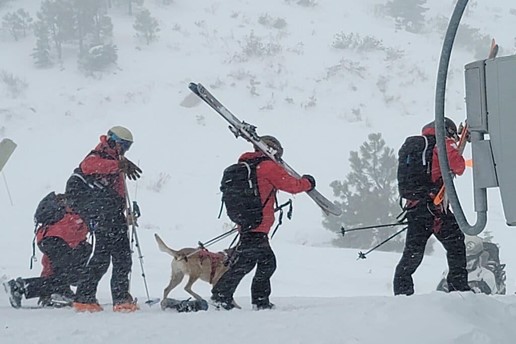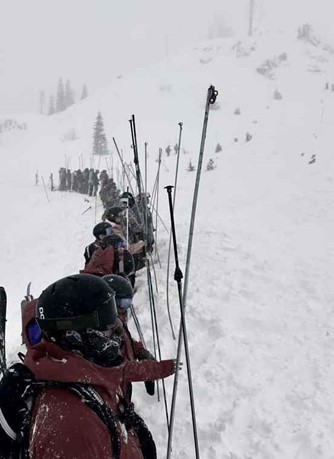Thousands of visitors flocked to the largest ski resort in California on Wednesday January 3rd for what promised to be a powder day, but on this day it was the setting of a tragedy. As a western storm raged on with gusts up to 38 miles per hour and promises of 2 feet of snow at the peaks of Lake Tahoe, members of Palisades Ski Patrol diligently monitored the area for avalanche conditions while marking hazards accordingly to keep their guests safe. The Sierra Avalanche Center had issued warnings Wednesday morning stating “A strong winter storm will enter our area today bringing high intensity snowfall and gale force winds…Avalanche danger will quickly increase today” and categorized the risk of avalanche as a 3 (considerable) on the 5-point scale.
Around 9:30am, an avalanche was triggered on the steep slopes of the GS Gully near the KT-22 lift resulting in a debris field approximately 150 feet long and 450 feet wide with a depth of 10 feet, per the Placer County Sheriff's Department. The resort closed immediately, and search teams were deployed to rescue any victims. One male skier, identified as 66-year-old Kenneth Kidd, sustained fatal injuries and was pronounced dead at Tahoe Forest Hospital. Three other skiers were treated for non-life-threatening injuries and later released.

Rescue crews are deployed to search for victims of the avalanche. (The New York Times)

Skiers forming a probe line to help search for the buried victim. (Instagram)
Not only are avalanche fatalities rare, but they historically take place in backcountry settings. Only seven out of the 243 reported US avalanche fatalities in the last decade occurred in-bounds at a ski resort thanks to diligent avalanche control efforts. Warmer temperatures caused the Lake Tahoe area to receive less snow to date compared to previous years and the snow itself had a low water content that theoretically makes avalanches less likely. The timing of this incident may be the only factor consistent with classic avalanches as most occur in December and early January when the snowpack is weaker.
Avalanches occur when unstable terrain dislodges and cascades down a steep slope. Each of the nine types are described based on size, character, location, and likelihood of being triggered. As an avalanche advances it continues to pick up more snow and as a result can weigh up to a million tons. This, along with other medical considerations, contributes to the 25% overall mortality rate. In a complete burial, this mortality rate rises to 50% - a statistic that is significantly time-dependent. The “survival phase” encompasses the first 15-20 minutes of burial and incurs a survival rate of 90% which drops down to 30% in the “latent phase” when someone has been buried for more than 35 minutes. Major factors that play a role in mortality include asphyxiation, traumatic injuries, and hypothermia.
Asphyxiation during complete burial causes 75% of avalanche-associated deaths and is due to a combination of airway obstruction, poor chest expansion, and oxygen starvation. Densely packed snow makes breathing difficult as the available oxygen is consumed leading to hypoxia and increased work of breathing. Patients are then left to inspire their previously expired carbon dioxide resulting in hypercapnia.
Hypothermia is the third constituent of “triple H syndrome” (hypoxia, hypercapnia, and hypothermia) and, if prolonged, can lead to dangerous arrhythmias that may be further provoked in the process of extrication. The HOPE (Hypothermia Outcome Prediction after ECLS) score can be used to predict survivability in these patients and indications for transport to an ECLS facility.
Those participating in winter sports, especially in backcountry regions, can proactively assist in their own recovery by carrying an avalanche transceiver and receiving training in avalanche education and practice those skills annually. Importantly, transceivers are a one-way communication tool only to be utilized when one finds himself trapped under snow and are therefore essential to backcountry recreational excursions.
The Wilderness Medical Society Practice Guidelines makes the following recommendations:
- If caught in an avalanche, a victim should protect the airway and create an air pocket by reaching across the face with an arm, placing the crook of the elbow over the mouth. (Grade 1C)
- In situations with buried victims without transceivers, a probe line should be initiated. Initial probe pass should be limited to a depth of 1.5m using Three Holes per Step or Slalom Probing methods to cover a 50x50m grid. (Grade 1C)
- If a completely buried victim is in cardiac arrest that has clearly been caused by trauma, rescuers should withhold resuscitation. (Grade 2B)
- If the duration of burial is >60 minutes, the core temperature is <30C, and the victim had a patent airway, arrest may be due to hypothermia; CPR should be continued and the patient transported to a hospital with ECLS capability. (Grade 2B)